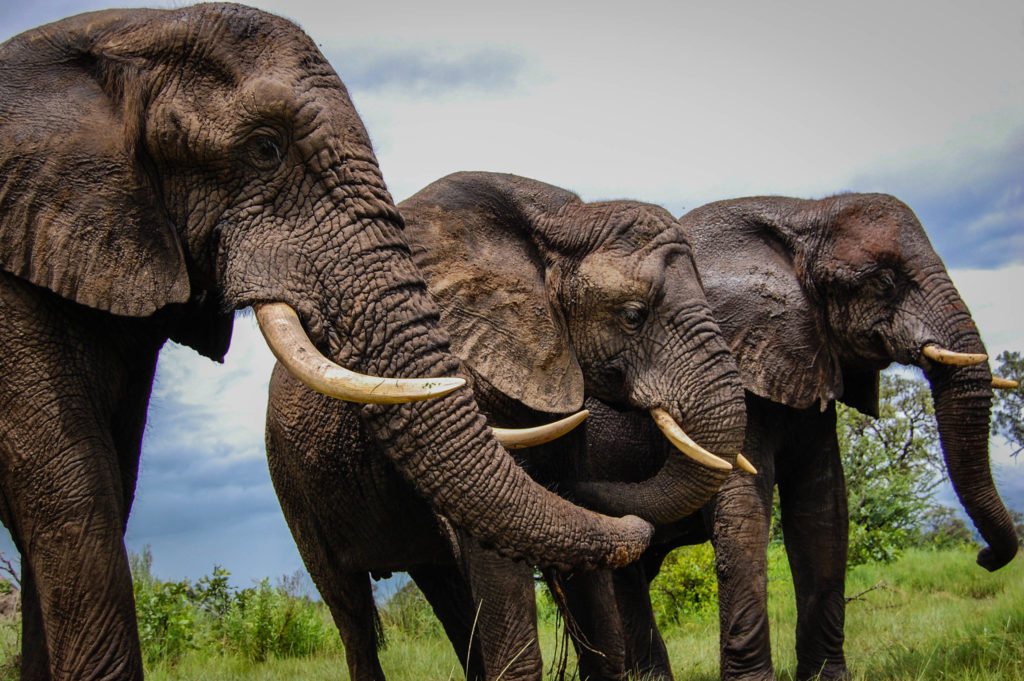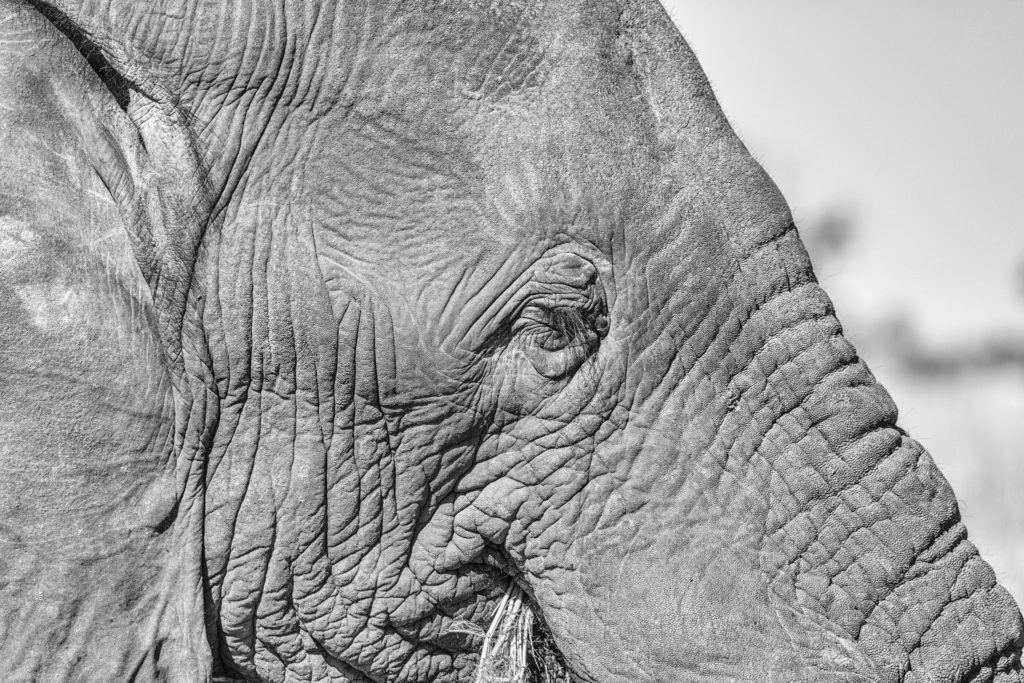Written by Ross Harvey
Botswana, as is now clearly documented in peer-reviewed literature, has an elephant poaching problem, not an overpopulation problem. Between 2014 and 2018, the population has remained roughly stable at around 130,000 elephants. However, an unknown number of these elephants are part of a migratory population shared with neighboring countries. Nevertheless, the population is statistically stable.
Rowan Martin, veteran wildlife manager, quotes a continent-wide figure of 541,684 elephants from the 2016 African Elephant Status Report (AESR). But that report puts the estimated figure based on reliable surveys at 415,428. Martin’s upper-bound figure includes best guesses on numbers outside of surveyed areas.
Botswana is accordingly home to approximately 32% of the African elephant population. Citing increased human and elephant conflict, the need to control supposedly burgeoning numbers and resentment over the hunting moratorium imposed in 2014 – which some communities say left them without meat and income – Botswana recently lifted its hunting ban.
I have argued that elephants are being reduced to a political football, caught between the views of Botswana’s current president and his predecessor. Others have indeed argued that this is a vote-catcher that could go horribly wrong. Some have chosen to label arguments against elephant trophy hunting as ‘mud-slinging’ that insinuates that ‘native Africans’ can’t manage their own natural resources. This is a pity, as it detracts from the substance of the debate, which is substantiated by evidence in scientific articles.
I argued that at least five myths inform the rationale for reintroducing hunting. Rowan Martin has responded to each of them in his article. Readers can make up their own minds. A brief response to each, in light of new research about elephant behavior, follows.

Three elephants in Botswana. Image credit Jeremy T. Hetzel, CC BY-SA 3.0.
Myth: Botswana’s elephant population is exploding
The African Elephant Status Report (AESR) to which Martin refers puts the elephant population figure at 50,000 in 1990. He shares the view that the population has exploded to a current figure of 160,000, quoted at the Kavango Zambezi (KAZA) conference in Kasane, Botswana earlier this year. But the AESR itself puts the 2006 figure at 154,658, notes that it’s disputed, and estimates the 2015 figure at 131,626, based on an Elephants Without Borders survey from 2014.
Martin takes issue with the widely accepted view that the Botswana population has been roughly stable between 2014 and 2018. However, if the AESR’s figure for 2006 is accurate, the population has fallen by 15% since then, so it remains unclear as to why Martin thinks that Botswana’s “elephant populations are growing, not stable.” It is also not clear what Martin means by the phrase that the “Botswana population is pumping out emigrants.” Elephants are migrating into Botswana from elsewhere to escape hunting and poaching, the country is hardly expelling them. The latest survey by Schlossberg, Chase and Landen (2018) has been lauded as one of the most rigorous scientific undertakings in this field, and it shows stable numbers at best, alongside a growing poaching crisis.
The growing populations are humans and cattle, not elephants. Outside protected areas, desertification caused by cattle over-grazing is a problem that too often gets ignored in this conversation. The cattle industry is ecologically and economically costly but politically powerful. Water is also increasingly scarce, which will only exacerbate human and elephant conflict. Hunting will not solve this problem; appropriate land use planning will.
Myth: Botswana’s elephants have exceeded the “carrying capacity” of the landscape
Martin has now placed on record that he agrees with the oft-quoted figure of a carrying capacity of 54,000 elephants in Botswana. That equates to about one elephant for every three square kilometers, based on an unscientific figure that seems to date back to a colonial era Hwange management plan. I argued that the concept is arbitrary and lacks relevance for large, unfenced wilderness landscapes. But Martin continues to insist that these landscapes are akin to farms that must be managed to ensure as little variation as possible. Martin and others have lamented the loss of large canopy trees as a result of elephant “over-population.” But they haven’t responded to the science that shows the importance of inter-seasonal variation, elephants’ roles as ecosystem engineers, and the fact that there is no benchmark as to what a landscape should look like. This is what makes the notion of carrying capacity arbitrary.
Martin simply dismisses the extensive science I quoted by dismissing the authors as “pseudo-scientists.” His criteria for determining what constitutes pseudo-science seems to be anything that contradicts with his own experience or cited literature. He betrays himself when he argues that man “does not need ‘scientific criteria’ in his aesthetic quest as long as he is practicing adaptive management.” The literature he cites in support of this is work produced by himself and Marshall Murphree.
On the subject of adaptive management, Martin favors culling to reflect his aesthetic preferences. He did not deal with the facts on the table, the most salient of which is that elephant populations grow exponentially after culling. It also remains difficult to see why Martin doggedly insists on culling when the Botswana population is not growing.
Culling and hunting make elephants extremely aggressive, as evidenced by the response of the Gonarezou population in Zimbabwe. It is highly traumatic. Far from reducing human and elephant conflict, it is likely to inflame it at the same time as damaging a country’s tourism reputation.

Close up of an elephant seen in the Okavango Delta, Botswana. Image credit Michael Levine-Clark, CC BY-SA 3.0.
Myth: Hunting will solve the elephant population “explosion”
Martin argues that this myth is redundant, because we know that trophy hunting only eliminates a small number of bull elephants each year. But this misses the fact that this myth is one of the core pretexts on which the re-introduction of trophy hunting has been rationalized. It also misses the deeper point that trophy hunting is likely to lead to long-term negative changes in population dynamics, especially if it annihilates older bulls.
Martin’s appeal to the report by Craig, himself and Debbie Peake amounts to a case of special pleading. A high and consistent “trophy standard” in the 15 years leading up to 2010 is no guarantee that such a standard will be maintained from 2019 onwards, especially given the notoriety of corruption in the industry. Nor does it mean that a high “trophy standard” reflects good ecological management. The quota numbers for some areas were based on no science at all. But the primary reason why hunting will fail is that there are very few so-called trophy tuskers remaining, as genetic depletion is real and scientifically documented, largely as a result of poaching. Martin ignores the figures I presented about how few trophy bulls over the age of 35 are left in Botswana.
Furthermore, the evidence is now unequivocal: “Male elephants increased their energetic allocation into reproduction with age as the probability of reproductive success increases. Given that older male elephants tend to be both the target of legal trophy hunting and illegal poaching, man-made interference could drive fundamental changes in elephant reproductive tactics.” The reproductive success of a male elephant increases with age; there is no such thing as a “surplus” bull who can be extracted as a “trophy” without population effects. Therefore, a combination of poaching and trophy hunting may well lead to population collapse, or at least to undesirable lasting population changes.
Myth: Hunting will solve human and elephant conflict
I am fully in favor of recognition of the rights of local communities, who are on the frontlines of conservation. Martin is right that status conferred is more important than benefits derived. He contradicts this point by arguing that hunting is an essential component of the system because of the added value it brings to communities. Many communities do not want to return to hunting, and no credible NGO working in Botswana thinks that a return to trophy hunting is wise. Martin also correctly asserts that the Botswana government called for tenders in previous hunting concessions but incorrectly asserts that no one wanted them. He fails to mention that a large part of the reason no one wanted those concessions is that the Botswana Tourism Organisation insisted that the land use be photographic and wanted substantial signature bonuses. But blindly insisting on photographic lodges in geographically unamenable areas lacks wisdom. Self-drive tourism, for instance, was precluded and therefore never explored, even though it was frequently promoted in those concessions’ management plans. To argue that the hunters were right, after all, does not follow.
Myth: The hunting moratorium led to more poaching
I debunked this myth by showing that Botswana’s poaching problem only started to escalate just before 2017, three years after the hunting ban was imposed. Martin argues that the AESR puts “the inception of severe illegal hunting at around 2006.” It’s not clear whether he means for Botswana or for the whole African population. But either way, that would clearly destroy his argument that hunting presence is necessary to ameliorate poaching. Hunting was at its peak in 2006. Moreover, hunting presence in places like the Selous Game Reserve in Tanzania and Niassa in Mozambique abysmally failed to counter poaching, which is an argument no one seems to want to address. To argue that hunters could do nothing about politically protected poaching gangs is an all too easy get out of jail free card. Where Martin is right is that communities should be far more involved in land-use planning and that rights devolution needs to be a priority. None of this means, however, that allowing western trophy hunting is a sensible policy choice.
Featured image: an adult and baby elephant seen in Chobe National Park, Botswana. Image credit Steven dosRemedios, CC BY-SA 3.0.





